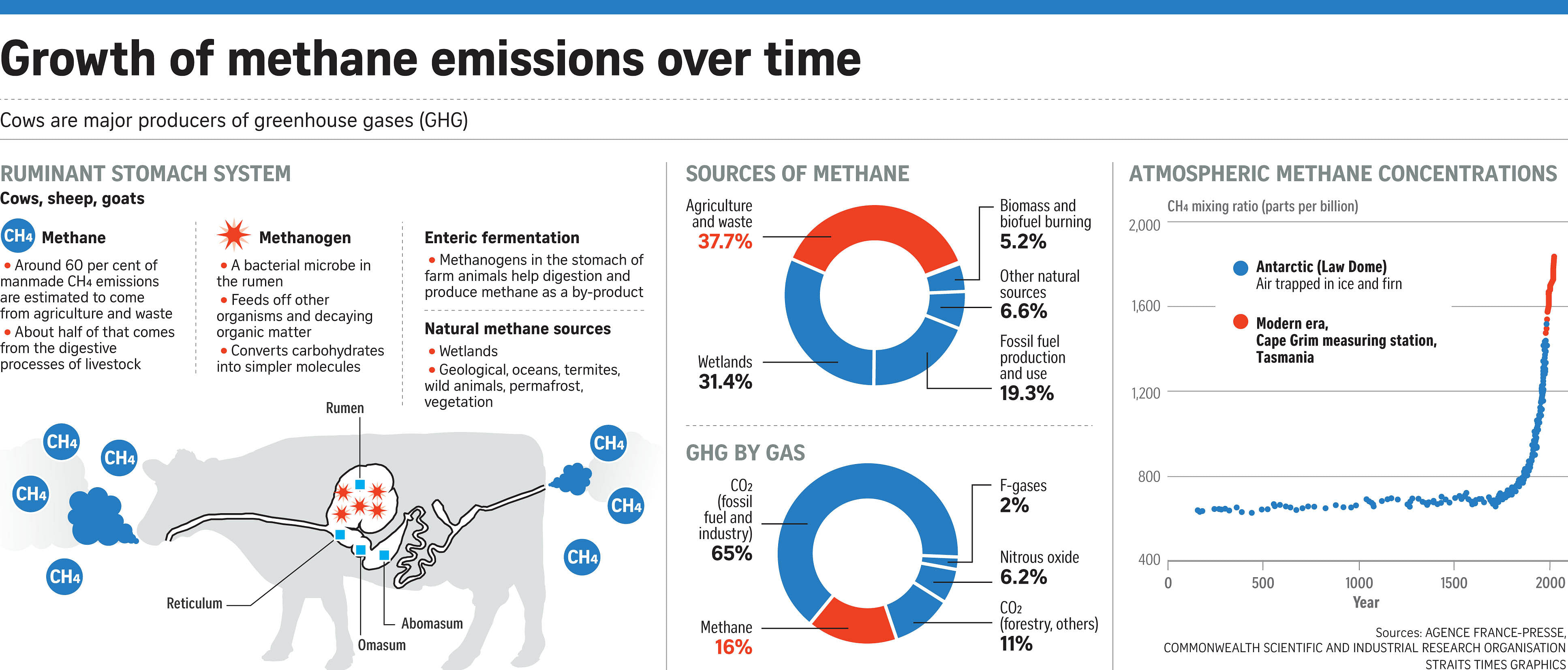Global methane emissions soar to record level: Study
Sign up now: Get ST's newsletters delivered to your inbox
Follow topic:
Emissions of the powerful greenhouse gas methane have reached a record, a global analysis has found, driven in large part by mankind's unrelenting demand for beef and energy, particularly liquefied natural gas (LNG).
Methane is a key component of natural gas and is far more effective in trapping heat in the atmosphere than carbon dioxide (CO2) - the main greenhouse gas.
While there is a lot more CO2 in the air, adding methane is like pouring fuel on a fire and is giving climate change an extra kick.
The Global Methane Budget, published this week in the journals Earth System Science Data and Environmental Research Letters, studied the growth of the gas in the atmosphere from 2000 to 2017, the latest year for which global data is available. It also studied the "sinks", where methane is destroyed over time in the air and soil.
The analysis revealed nearly 10 per cent growth in methane emissions over the period and that about 60 per cent of all emissions are man-made, mainly from agriculture and fossil fuels. The rest comes from wetlands and other natural sources.
The relentless rise in methane is bad news because, combined with growing CO2 emissions, the world is on a path to warm by around 3 deg C by the end of the century.
Making deep cuts in both, and soon, can help the world avert increasingly severe storms and droughts and faster sea level rise.
"The controversy is who is the worst offender in terms of methane growth in the atmosphere - is it cows or the fracking guys?" said Dr Pep Canadell, executive director of the Global Carbon Project, which conducted the nearly four-year analysis in collaboration with about 70 institutions globally.
"As this paper shows... agriculture is still more important - there are still more emissions from farming than fossil fuels," Dr Canadell, one of the study's authors, told The Straits Times from Canberra yesterday.
He said that livestock, particularly cows and sheep, was the largest source of mankind's methane emissions, driven in part by the growing middle-class demand for meat.
Rice farming is another major source of methane, along with manure, wood burning and bush fires, and even termites.
Ruminant animals, such as cows, burp out a lot of methane during digestion of their food. One way to tackle this has been to feed cows supplements that cut down the amount of methane they produce.

Surging demand for natural gas and, until relatively recently, coal, has also been a big driver. Methane comes from coal mines, leaky gas pipelines, oil and gas wells, and even household cooktops.
Methane emissions grew quickest in three regions: Africa and the Middle East; China; and South Asia and Oceania, including Australia, said the study.
Dr Canadell said a surge in coal use and coal mining caused methane emissions to jump in China until 2013, when coal use there largely plateaued. Since then, the explosive growth of LNG production and consumption has helped accelerate levels of the gas in the atmosphere.
The good news is that methane does not last very long in the atmosphere - about nine years before it is broken down, versus the lifetime of centuries to thousands of years for CO2."Reducing methane emissions is therefore recognised as an effective option for rapid climate change mitigation," the scientists said.
Fixing leaky pipelines and oil and gas wells, as well as overhauling agriculture are all vital steps to reduce methane emissions.
But Dr Canadell has doubts the natural gas sector's methane emissions will drop in the near term, given the demand for energy.

